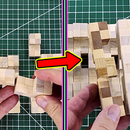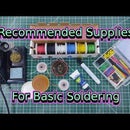Introduction: Make an Infinity Mirror Cube
As I was looking up information when making my first infinity mirror, I came across some images and videos of infinity cubes, and definitely wanted to make one of my own. The main thing that was holding me back was that I wanted to do it differently than anyone else. I think I finally came up with a design that is different.
This project uses some custom made circuit boards that I used instead of LED strips. LED strips could also be used, but these allowed me to choose the spacing for the LEDs to get the size of cube that I wanted.
If you would like to watch a video version of this Instructable, you can watch that here: https://youtu.be/tmyQh9ZPkBg
Supplies
Tools
- Precision Tweasers
- Soldering Iron
- Straight Edge Ruler
- Jig Saw
- Jig Saw Blade
- Drill
- Drill Bit 1/16"
- Utility Knife
- Wire Cutters
- Pliers
- Rubber/Plastic Hammer
- Hot Glue Gun
- Sharpie
Parts
- Custom PCBs
- 96 - Addressable LEDs
- 96 - Capacitors, Size 104
- LED Wire Connectors
- Arduino Nano
- Plexiglass, 3/16" Thick (minimum 8" x 11")
- Thumb Tacks
- One Way Mirror Window Tint, Silver
- 3/8" Ring Magnets
- 1" Square Dowel
- Touch Sensors
- Barrel Plug
- 5v Power Supply
Supplies
Step 1: Start With the Addressable LED Strips
For my cube, I used some custom made strips, you can check out my Instructable for that process here: Make Custom LED Strips
For whichever strips you use, you will need 12 that are equally sized. Before connecting the 12 strips together, I need to discuss the layout. I drew out a diagram to help me plan the connections. I have included it in this step, feel free to print it out. I numbered all of the strips, and the arrows in the diagram match the flow of the data connections.
The data is input at strip 1 then goes to 2, then 3, then 4. The diagram shows 5 twice, but they are really both the same strip. The same with 6 and most of the rest. But now at 7 notice the squiggly lines. At 7 the data path comes to a dead end, so I added a wire to bring the signal back over to 8. Then it goes to 9, and then 10. Here we have another dead end, so I added another wire to bring me back to 11. After 11 there isn't a direct connection to 12, so I use a third wire to bypass 2 to get me from 11 to 12. And that's the end of the data path. Overall I added 3 bypass wires with the strips.
Step 2: Connect the LED Strips
When wiring the LED strips together, I used a wooden jig that I made to hold 3 of them together at a time. Each group of 3 strips only had 2 strips connect directly here. For all 3 positive (+) connections I connected for all 3. For all 3 negative (-) connections I connected all 3. The data wire just followed the data path.
I ended up with 4 of the groups of 3, then I followed these same steps for to connect each of those.
Once all of the LED strips are connected together, I added the 3 bypass wires (the red wire in the picture.) It's a good idea to test the LEDs at this point, before putting them in the box.
Step 3: Test Fit the Part of the Box
6 pieces of plexiglass are needed, 3 1/2" x 3 3/16". The picture shows how I assembled them with exaggerated lengths. I held the pieces together with painters tape.
Once all 6 pieces are together, I marked in 1/4" from all corners on all sides. Then I take the box apart and at all of these marks I drill a 1/16" hole.
Step 4: Apply the Semi-Transparent Film
I removed one side of protective film from the plexiglass pieces. 3 at a time, I applied the partially reflective film, smoothing out the bubbles with an old gift card. I cut apart the 3 pieces and trimmed away the excess film.
After this was done, I needed to cut away a bit of the film so that the sides of the box can be glued together. I only trimmed away on the sides of the longer length. What this means is that the final film on the plastic should be a square that is about 3 3/16" x 3 3/16". If a bit extra is trimmed away, that's ok because that part will be hidden behind the LED strips.
Step 5: Add the Thumbtacks
One key part of the design/function are the thumbtacks in the corners. For most of the corners, I trimmed the point of the thumbtack to be short. Then I glue the thumbtacks into the small holes of the corners. (I used E6000, but I'm sure other glues would work too.)
That was MOST of the corners. For 3 of the corners I did NOT use trimmed thumbtacks, and I did NOT glue them into the holes. In the next step I explain more.
Step 6: Add the Wires Inside of the Box
For the final 3 thumbtacks, I use those to get the power and data connections inside the box. I add solder to the the tip of the thumbtacks to tin them. Then I put them in the holes, and using a plastic mallet I bend the tip of the wire. Now I can solder a wire to the thumbtack. I use 3 different colors of wires for the 3 different thumbtack connections.
Step 7: Glue Half the Box Together
We are now ready to assemble the box. Start with these 3 sides, gluing them together with the wired thumbtacks next to each other.
Once the glue sets, I used hot melt glue to hold these wire into the corner edges of the box, in different directions.
Step 8: Wire the LED Strips Into the Box
With these 3 wires secured in those edges, I left the length of the wires long to give me room to work with. I soldered the green wire to the data input connection of the first LED strip. The red wire I soldered to any positive (+) connection, and the white wire to any negative (-) connection. Now it's ready for all of the other sides to be glued in place.
Step 9: Final Decorations
After that glue sets, I remove all of the tape and protective film. Before I lose track of which thumbtacks are for power and data, I mark them with a marker, indicating which wire it's connected to.
I marked straight lines 1/2" in from all edges. I use these lines as a guide to help me place the aluminum tape (2 1/2" x 1") along the edges. Make sure the aluminum foil doesn't touch any of the thumbtacks.
Step 10: *** IMPORTANT *** Design Consideration for the Cube
When I first made the cube, there was one thing I didn't consider until it became an issue for me. I'm adding this step to this Instructable since it's very important. *** DO NOT SKIP THIS STEP ***
Since I used a metal tape for decorating the cube, that tape will conduct electricity. It's only 5 volts in my project, so not enough to be a shocking hazard. The issue I had was shorting out the circuit. This can happen because the tape crosses over the corner edges of the cube. When making your design, take this into consideration. Either design it so that the metal tape (if you use metal tape) only stays on one side of the cube, or you could add a coating to the tape. Something like clear fingernail polish should even work. Since my cube was already completed and I like the look of my design, I went another route.
Since I had continuity between different sides of the cube because of the tape, I needed to break that continuity. I filed the tape away, just at the corner edges. You can see from the pictures I included with this step that I only filed away enough to break that connection between the different sides. Filing directly on the corner helped me keep the change in appearance small and almost completely unnoticeable.
Step 11: The Support Tower
I'm not going to go into much detail about the support tower that I used because I'll be rebuilding it and making an Instructable specific for that. But here is some info about this one.
It has an Arduino Nano for control. The tower has 3 pillars, each one with a gap carved out for the Arduino and wiring. The gap is positioned so that even after the pillars are glued together, I still have access to the mini USB port of the Arduino.
At the top of the tower you can see a thumbtack in each of the 3 pillars. These are connected to the Arduino and provide the power and data connection to the cube. Each tower I have labeled to match the labels I made on the cube connections. These tower thumbtacks have magnets with them to help ensure a steady connections with the cube.
At the bottom of the tower you can see a thumbtack in each of the 3 pillars. These are for capacitive touch sensors to change different options available in the Arduino program.
Step 12: And That's It for Now!
And that's it!
This infinity cube has no external wires on the cube itself. Although this means it won't light up when being held, I still like it like this. It doesn't have many functions yet, but it's definitely not permanent. If you have any ideas for lighting patterns, or any other suggestions on the design, please comment and let me know.
Here is a link to my GitHub page that has the Arduino Nano code and PCB Gerber files: https://github.com/HowDoYouDIY/InfinityCube
Thanks for checking out my Instructable! I would love to see your infinity cube!
Social Media:
- Twitter - https://www.twitter.com/HowDoYouDIY
- Facebook - https://www.facebook.com/HowDoYouDIY
- Instagram - https://www.instagram.com/howdoyou.diy

Participated in the
Make it Glow Contest











